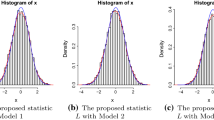Abstract
The analytical method for simple structure proposed by Thurstone is applied to four separate cases and found to yield satisfactory results. The simple structure obtained by Thurstone's method is found to match closely that obtained by other methods and corresponds to the true structure of the matrix in those cases where true structure is known. Difficulties about the choice of the correct trial vector led the writer to develop a modification of Thurstone's method, useful where high speed computational facilities are available. Instructions are given for this so-called mass modification, and the procedure is illustrated with a 5-factor, 14-variable example. While the results do not fully correspond to a previous graphical solution, it can be argued that the results obtained by the new method show an improved simple structure. The modified method is applied to three other correlation matrices, yielding in each case a satisfactory simple structure.
Similar content being viewed by others
References
Carroll, J. B. An analytical solution for approximating simple structure in factor analysis.Psychometrika, 1953,18, 23–38.
Cattell, R. B. and Cattell, A. K. S. Factor rotation for proportional profiles: analytical solution and an example.Brit. J. statist. Psychol., 1955,8, 81–91.
Ferguson, G. A. The concept of parsimony in factor analysis.Psychometrika, 1954,19, 281–290.
Fruchter, B.Factor analysis. New York: Van Nostrand, 1954.
Johnson, D. M. and Reynolds, F. A factor analysis of verbal ability.Psychol. Rec., 1941,4, 183–195.
Neuhaus, J. O. and Wrigley, C. The quartimax method: an analytical approach to orthogonal simple structure,Brit. J. statist. Psychol., 1954,7, 88–92.
Pinzka, C. and Saunders, D. R. Analytic rotation to simple structure, II: Extension to an oblique solution. Educational Testing Service Bulletin, RB-54-31, 1954. (Multilithed)
Saunders, D. R. An analytical method for rotation to orthogonal simple structure. Educational Testing Service Bulletin, RB-53-10, 1953. (Multilithed), (alsoAmer. Psychologist, 1953,8, 428. (Abstract))
Sokal, R. R. Quantification of systematic relationships and of phylogenetic trends. Montreal: Proc. Tenth Internat. Congr. Entomology, 1958, in press.
Sokal, R. R. A comparison of five tests for completeness of factor extraction. 1958, (in preparation).
Stroud, C. P. An application of factor analysis to the systematics ofKalotermes.Syst. Zool., 1953,2, 75–92.
Thurstone, L. L. An analytical method for simple structure.Psychometrika, 1954,19, 173–194.
Tucker, L. R. The objective definition of simple structure in linear factor analysis.Psychometrika, 1955,20, 209–225.
Wright, S. General, group, and special size factors.Genetics, 1932,17, 603–619.
Wright, S. The interpretation of multivariate systems.Statistics and mathematics in biology. Ames, Iowa: Iowa State College Press, 1954.
Author information
Authors and Affiliations
Additional information
Contribution No. 961 from the Department of Entomology, University of Kansas, Lawrence, Kansas.
Most of the work on which this paper is based was performed during the summer of 1956 when the author was the holder of an Elizabeth Watkins Faculty Scholarship granted by the Kansas University Endowment Association. The work was carried out at the University of Illinois, where the author was privileged to spend the tenure of this scholarship. The writer is indebted to Professor L. H. Lanier, the Chairman of the Psychology Department, who graciously placed space and equipment at his disposal, and to Professor Raymond B. Cattell for his continuing encouragement of and interest in the author's work. Some of the computations were performed on the ILLIAC digital computer. The many courtesies extended by Professor J. J. Nash, Director of the Digital Computer Laboratory of the University of Illinois, are gratefully acknowledged. The writer is indebted to Mr. John R. Hurley for much assistance during the development of the computational routines and for a critical reading of this paper. Expenses in connection with the work were met by a General Research Grant of the University of Kansas.
Rights and permissions
About this article
Cite this article
Sokal, R.R. Thurstone's analytical method for simple structure and a mass modification thereof. Psychometrika 23, 237–257 (1958). https://doi.org/10.1007/BF02289237
Received:
Revised:
Issue Date:
DOI: https://doi.org/10.1007/BF02289237




